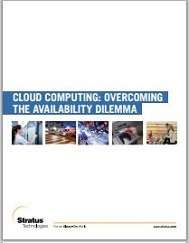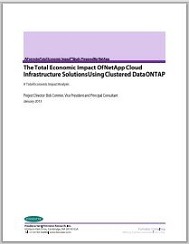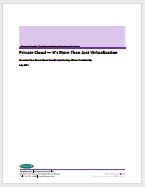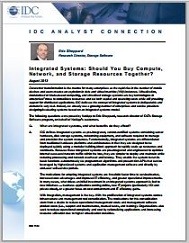Organizations of all sizes are moving their workloads to the cloud to gain the increased flexibility and scalability needed to manage evolving business demands. In fact, 75% of enterprises now use at least some form of cloud computing. But many organizations continue to proceed with caution — moving only select workloads to the cloud. Why not go all in? The answer is simple: availability concerns. Download our white paper, “Cloud Computin...
You Are Browsing ‘Cloud ’ Category
Today's enterprise IT organization is being asked to architect a network that can handle more requirements than ever before. Connectivity between public and private cloud data centers and the end user typically incorporates a 4th tier where application delivery appliances reside. It's now necessary that the 4th tier extend further, reaching across the public Internet to ensure performance and control beyond the data center.
...
This Forrester study was commissioned by NetApp and highlights the costs and benefits of deploying a cloud infrastructure using Data ONTAP across the enterprise. The findings of this study are in large part based on in-depth interviews conducted by Forrester with customers that currently use the NetApp solutions. This study highlights the estimated return on investment (ROI) for the organization and presents aggregate findings derived from the intervi...
Many organizations have adopted virtualization as a standard for server workloads. But virtualization has not proven to be the “game changer†many organizations had envisioned. IT departments face huge challenges related to server sprawl, which has actually increased with virtualization.
Although virtualization has brought benefits beyond the physical paradigm of one operating system per server, the true optimal infrastructure for organ...
NetApp and Amazon Web Services (AWS) are joining forces to deliver NetApp Private Storage for AWS, which combines the performance, security, and compliance of dedicated storage with the economics and agility of public cloud.
The solution, which offers a new tier of storage for AWS users, enables bi-directional data mobility for existing NetApp customers between on premises storage and NetApp Storage residing in a Direct Connect co-location facility...
As the rapid rise in the number of mobile devices and users creates an explosion in data and virtual machine instances, datacenter transformation becomes imperative for many enterprises. It is essential enterprises move to consolidate resources and cut both capital and operating costs while still providing support for distributed applications.
This brief white paper delves into a Q&A with Eric Sheppard, research director of IDC’s Storage...
As companies transition from traditional, infrastructure-focused deployment architectures to cloud-ready, cloud-enabled and service-centric delivery models, they need to change the way their storage is architected as well.
Check out this informative paper to learn how to prepare for IT-as-a-Service (ITaaS) with the right storage architecture. Discover the answers to your most burning questions surrounding the private cloud and ITaaS. Read on to lea...
As business purposes have changed over the years, IT approaches and infrastructures have had to change in lock-step to serve them optimally.  IT professionals are now combining the best of the centralized approach – via virtualization, federation, and clouds of all sorts – with the best of the decentralized model – via mobile and localized consumption and production.  In this paper, Enterprise Strategy Group examines approac...
To respond to rapid business environmental changes, enterprises are now adopting a more agile and services-oriented model for centralized IT, often characterized as “private cloud.† Public cloud service providers have become adept at adding new customers, new applications, and more compute-intensive workloads with minimal delay.  While traditional enterprise IT may not be able to fully emulate this model, they can use virtualization...










